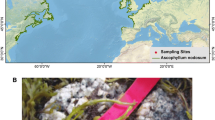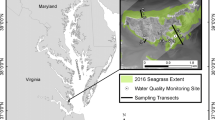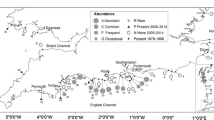Abstract
The red alga Gelidium robustum is important,because of its commercial exploitation in Mexico as araw material for the agar industry, providing 10% ofthe world production of agarophytes. In recent years,its annual harvest in Mexico has shownobvious,variations partly because of an increasedharvesting effort, but also because of environmentalchanges. An analysis is presented of the effect thatinterannual variability of the sea surfacetemperature, wind speed, and upwelling index had onthe relative abundance of this alga from 1980 to 1990.The results indicate a close relation betweenenvironmental fluctuations and the relative abundanceof this species. The response of G. robustum tothe different environmental conditions has not alwaysbeen equal. During El Niño 1982–84, the seasurface temperature was the most important factor andthere was a high negative correlation with therelative abundance. A lag period of three monthsshowed a positive correlation with upwelling index andwind speed. Under normal conditions and during LaNiña, the relative abundance of the alga showed apositive correlation with the sea surface temperature. For the upwelling index and wind speed, therelationship was similar to that during El Niño.
Similar content being viewed by others
References
Anderson TW (1972) The Statistical Analysis of Time Series, John Wiley & Sons, Inc. U.S.A. 704 pp.
Bakun A (1973) Coastal upwelling indices, west coast of North America, 1946-71, U.S. Dept Commer. NOAA Tech. Rep. NMFS SSRF-671. 103 pp.
Barilotti CD, Silverthorne W (1972) A resource management study of Gelidium robustum, Proc. Seventh International Seaweed Symp, 255-261.
Borja A (1994) Factores ambientales que influyen en el crecimiento, producción y desprendimiento de biomasa en praderas naturales de Gelidium sesquipedale (Clem.) Born. et Thur. en el País Vasco (N de España), Sci. Mar. 58: 251-260.
Dayton PK, Tegner MJ (1989) Bottoms beneath troubled waters: bentic impacts of the 1982-1984 El Niño in the temperate zone. In Glynn PW (ed.), Global Ecological Consequences of the 1982-83 El Niño-Southern Oscillation. Elsevier Oceanography Series, USA. 150 pp.
Fralick RA, Baldwin HP, Neto AI, Hehre EJ (1990) Physiological responses of Pterocladia and Gelidium (Gelidiales, Rhodophyta) from the Azores, Portugal. Hydrobiologia 204/205: 479-482.
Hernández-Guerrero CJ, Casas-Valdes M, Ortega-García S (1999) Cosecha comercial del alga roja Gelidium robustum en Baja California Sur, México. Rev. Biol. Mar. y Oceanogr. 34: 91-97.
Huyer A (1983) Coastal upwelling in the California Current system. Progr. Oceanogr. 12: 259-284.
Juanes JA, Fernández C (1988) Ciclo anual y producción de Gelidium latifolium (Grev.) Thur. et Born. (1876), en la región de cabo Peñas (Asturias, N. de España). Inv. Pesq. 52(1): 109-122.
Lynn RJ, Simpson JJ (1987) The California Current System: The seasonal variability of its physical characteristics, J. geophys. Res. 92(12): 12947-12966.
Mann KH, Lazier JRN (1991) Dynamics of Marine Ecosystems: Biological-Physical Interactions in the Oceans, Blackwell Sci. Publs, Boston. 466 pp.
McHugh DJ (1991) Worldwide distribution of commercial resources of seaweeds incluiding Gelidium. In Juanes JA, Santelices B, McLachlan JL (eds), International Workshop on Gelidium, Kluwer Academic Publishers, The Netherlands, 19-30.
McQuaid CD (1985) Seasonal variation in biomass and zonation of nine intertidal algae in relation to changes in radiation, sea temperature and tidal regime, Bot. mar. 28: 539-544.
Norton J, McLain D, Brainard R, Husby D (1985) The 1982-83 El Niño event off Baja and Alta California and its ocean climate context. In Wooster WS, Fluharty DL (eds), El Niño North. Wash. Sea Grant Univ. Mash, Seattle, 45-72.
Oliger P, Santelices B (1981) Physiological ecology studies on Chilean Gelidiales. J. exp. mar. Biol. Ecol. 53: 65-75.
Santelices B (1974). Gelidioid algae, a brief resumé of the pertinent literature, Tech. Rep. Mar. Agron. Sea Grant Program, Hawaii No. 1. 111 pp.
Santelices B (1991) Production ecology of Gelidium, Hydrobiologia 221: 31-44.
Santos R, Duarte P (1991) Marine plant harvest in Portugal. J. appl. Phycol. 3: 11-18.
Rico JM (1991) Field studies and growth experiments on Gelidium latifolium from Asturias (Northern Spain), Hydrobiologia 221: 67-75.
Zertuche-González JA (1993) Situación actual de la industria de las algas marinas productoras de ficocoloides en México. In: Situación actual de la industria de macroalgas productoras de ficocoloides en América Latina y el Caribe. Documento de campo No. 13. FAO, México: 5-15.
Zimmerman RC, Kremer JN (1986) In situ growth and chemical composition of the giant kelp, Macrocystis pyrifera: response to temporal changes in ambient nutrient availability, Mar. Ecol. Progr. Ser. 27: 277-285.
Author information
Authors and Affiliations
Rights and permissions
About this article
Cite this article
Hernández-Guerrero, C.J., Casas-Valdez, M., Ortega-García, S. et al. Effect of climatic variation on the relative abundance of the red alga Gelidium robustum in Baja California Sur, Mexico. Journal of Applied Phycology 12, 177–183 (2000). https://doi.org/10.1023/A:1008103120247
Issue Date:
DOI: https://doi.org/10.1023/A:1008103120247




